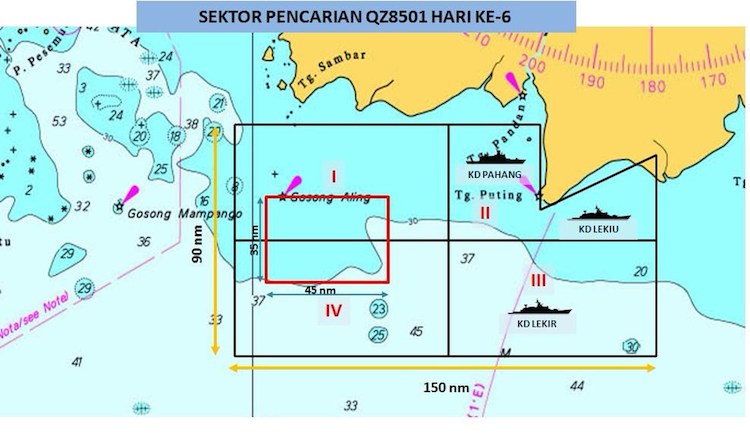Five days after Indonesia AirAsia flight QZ8501 disappeared from radar over the Java Sea, and three days after the first confirmed débris from the Airbus A320 was located, the recovery effort is being hampered by moderate gales and rough seas.
With numerous maritime and airborne elements involved in the recovery, precise numbers of bodies located, retrieved and returned to shore are perhaps understandably fluid, with between six and 16 retrieved bodies quoted today by officials. One cabin crew member is understood to be among the bodies returned to shore.
Once retrieved, the remains of the 155 passengers and seven crew are being transferred at local SAR headquarters Pangkalan Bun before being transferred to Surabaya, from which the flight originated.
The recovery operation is being impeded by seasonal weather conditions in the inter-tropical convergence zone, Indonesian Air Vice Marshal Sunarbowo Sandi, coordinating the operation, said. “It’s raining there. The waves are three or four meters and the wind is blowing 30 knots (56 km/h).”
30 knots is a moderate gale on the Beaufort scale, at the border of the operational envelope for many light helicopters, and can complicate routine SAR operation even for rotorcraft that can safely operate at those windspeeds.
Strong prevailing westerly winds, rough seas and easterly currents mean calculating the likely spread of bodies and débris in a week is complicated.
Malaysian Navy chief Admiral Abdul Aziz Jaafar confirmed Friday that the current search area is a four-sector box 90nm by 150nm (167km by 278km) — a total of 46,246 square kilometres, approximately two thirds the size of Tasmania. Operations on the land element of sector II are understood to be focussing on coastal areas.

A smaller area, outlined in red, is being termed the Most Probable Area, covering 1,575 square nautical miles (5,402 square km), slightly less than half the area of Sydney.
Fisherman and local villagers are also searching the remote Kalimantan coast on the island of Borneo, along which débris or bodies may have washed up.
In addition to finding bodies and débris on the surface, the operation is also focussing on the seabed location where officials believe the fuselage – or the most significant part of it – is resting, at approximately 3°22’15.0″S 109°41’28.0″E.
Reports suggest that sonar imaging from an Indonesian naval vessel resembled an inverted Airbus A320. Efforts to retrieve the cockpit voice recorder and flight data recorder are concentrating at that location. However, the 3-4m waves – which would correspond to the higher limits ‘rough’ on the Douglas sea scale — are precluding divers from operating.
In the event that this area is in fact the location of wreckage intact enough to be recognisable via surface sonar, it would suggest the aircraft struck the water largely intact.
Unconfirmed reports from ground radar leaked to local media suggested a remarkably steep ascent, followed by an even steeper descent and an exceedingly low ground speed, between the flight’s departure from normal flight and its disappearance from radar.
The two RAAF AP-3C Orion aircraft involved in the initial phase of the search have now returned to Australia.
“The two Orions, which left RAAF Base Darwin yesterday, recovered into Royal Malaysian Air Force Base Butterworth following their search flights. However, Indonesian authorities have advised that ADF assistance is no longer required,” Defence said in a statement, noting also that “the ADF will continue to maintain two liaison officers at Indonesia’s National Search and Rescue Agency (BASARNAS) and the Australian Defence Force stands ready to provide further assistance.”










